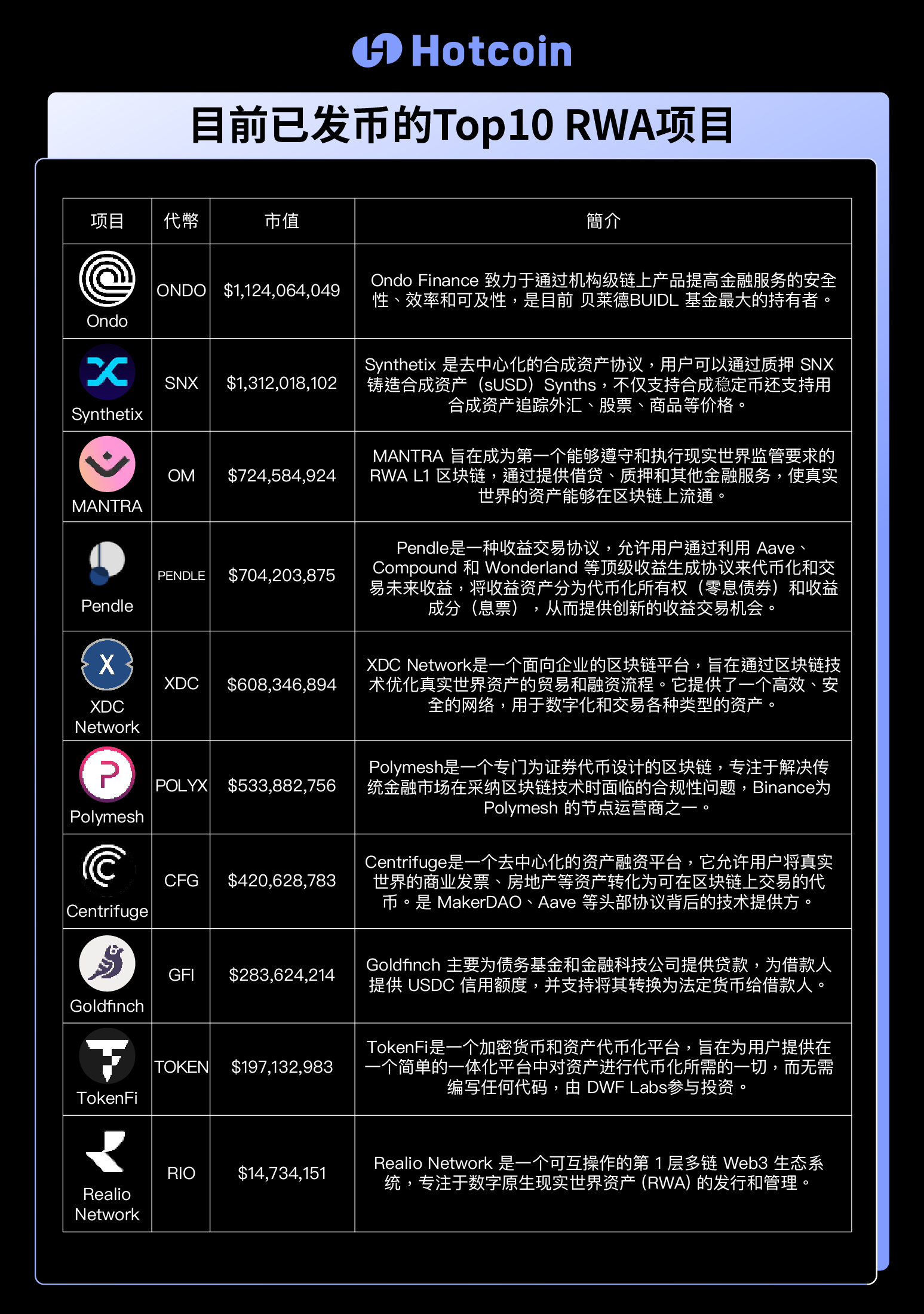With the continuous development and maturity of blockchain technology, crypto-assets have evolved from the original concept of Bitcoin to todays complex financial ecosystem, covering many fields from currency, lending to derivatives. People began to explore how to combine traditional financial assets with the emerging world of digital assets, and RWA gradually emerged. Traditional financial institutions such as Citibank, Franklin Templeton and JPMorgan Chase have begun to get involved in the RWA field. The recent launch of BlackRocks BUIDL fund has made the RWA track once again become a focus of attention.
1. Definition and implementation of RWA
RWA (Real World Assets) refers to the on-chain conversion of real assets, which refers to converting assets in the real world into digital assets that can be traded and circulated on the blockchain through the use of smart contracts and blockchain technology. These assets are physically or legally existing assets that can generate economic value, covering tangible assets such as real estate, art, and gold, as well as intangible assets such as stocks and bonds. The core value of RWA is to introduce these real-world assets into the digital asset market through tokenization, which not only retains the value characteristics of the assets themselves, but also gives them higher liquidity and accessibility. In fact, USDT, USDC and other stablecoins linked to the U.S. dollar are the tokenization of the U.S. dollar, a real asset.
The implementation of RWA is mainly based on the application of blockchain technology, using smart contracts to represent and manage the ownership or income rights of real assets, realizing functions such as asset segmentation, certification, and trading, and ensuring the accuracy and security of assets on the chain. nature, connecting real-world assets to the digital world through the process of tokenization. This process includes the following key steps:
1. Asset evaluation and certification: First, real-world assets need to be evaluated and certified in detail to determine their value and ensure their legality and authenticity. This step usually requires a professional agency or a third party to ensure the objectivity and accuracy of the asset assessment.
2. Digitization of assets: After the evaluation and certification are completed, the assets will be represented on the blockchain by issuing digital tokens. These tokens represent ownership or partial interest in real assets, which can be equity, debt, or other forms of property interest.
3. Smart contract design: While assets are being digitized, corresponding smart contracts will be designed to stipulate asset usage rules, distribution methods, income distribution, etc. Once a smart contract is deployed on the blockchain, its execution is fully automated, ensuring the transparency and non-tamperability of transactions.
4. Asset trading: Tokenized assets can be traded freely on the blockchain, and buyers and sellers can complete transactions directly through smart contracts without the need for traditional financial intermediaries, thereby reducing transaction costs and improving efficiency.
5. Rights realization: Holders of asset tokens can obtain corresponding asset use rights, income distribution or other rights and interests according to the provisions of smart contracts. For example, if the tokenized asset is real estate, token holders may receive distributions of rental income.
RWA creates new asset classes and investment opportunities, enhances the liquidity of real-world assets, and enables assets that are less liquid in traditional markets, such as real estate, art, etc., to be more widely traded globally. and utilization, thereby promoting the development of the real economy.
2. Main types of RWA
RWA can be classified in various ways and can be divided according to multiple dimensions such as the nature of the asset, liquidity, and industry. Each category of RWA has its specific market needs and investment characteristics.
1. Classification by asset nature
Tangible assets: including real estate, land, physical commodities (such as gold, oil), art, etc. These assets have a clear physical presence and are the most traditional and common type of RWA.
Intangible assets: including copyrights, patents, trademarks, etc. Although these assets have no physical form, they have economic value and can be digitized through blockchain technology to realize the transfer and transaction of value.
2. Classification by liquidity
Highly liquid assets: Such as gold, securities, etc. These assets can be bought and sold in a short period of time with a small price impact, and are the liquidity tools preferred by investors.
Low-liquidity assets: Such assets, such as real estate, art, etc., usually require longer time and more cost to buy and sell, but through the digitization of RWA, their liquidity can be improved to a certain extent.
3. Classification by industry
Financial assets: including but not limited to debt, equity, investment fund shares, etc. These assets are directly related to the financial market and are the focus areas of RWA digitization.
Non-financial assets: such as real estate, agricultural products, mineral resources, etc. Although such assets do not directly participate in financial market transactions, they are of great value. Through RWA digitization, new investment channels can be opened up for investors.
4. Classification by investment return method
Fixed income assets: Such as bonds, lease contracts, etc. These assets provide a stable flow of income and are suitable for investors with low risk appetite.
Equity assets: Such as company equity, investors can obtain company profit dividends or capital appreciation by holding equity, which is suitable for investors with higher risk appetite.
5. Classification by asset source
Traditional assets: These are assets that existed before the wave of digitalization, such as real estate, art, etc.
Emerging assets: With the development of technology and changes in market demand, emerging assets such as carbon credits, data rights, etc. have begun to appear. These assets represent the direction of innovation and development in the RWA field.
3. Current Development Status of RWA Market
The RWA market has shown significant growth over the past few years, with interest from asset owners, asset managers, and investors continuing to grow. According to CoinMarketCap data, the total market value of RWA concept tokens as of April 11 exceeded $8.8 billion, and is expected to continue to grow in the next few years.
According to rwa.xyz data, as of April 11, the total debt value of loan-type RWA projects reached US$4.4 billion, and the value of US Treasury debt-type RWA projects reached US$1.1 billion. It can be expected that the RWA track is likely to become a trillion-level increment in the future. market. According to the RWA concept section of the encrypted data platform RootData, there are a total of 130 RWA track projects, including 43 projects that have issued coins. According to a report from Citibank, almost anything of value can be tokenized. The tokenization of financial and real-world assets may be the killer application for blockchain to achieve breakthroughs. It is predicted that by 2030, there will be 4 trillion to $5 trillion in tokenized digital securities.
On March 20, BlackRock announced that it would cooperate with Securitize to launch the BlackRock USD Institutional Digital Liquidity Fund (BUIDL), a tokenized asset fund based on Ethereum. BUIDL mainly invests in cash, U.S. Treasury rolls and repurchase agreements. In just one week since its debut, it has successfully attracted over US$240 million in funding. Ondo Finance subsequently announced an investment of over US$95 million, accounting for over 33% of the BUIDL fund shares and is currently the largest holder of the BUIDL fund. Not only is BlackRock paying attention to RWA, other major financial investment institutions such as Citibank, Franklin Templeton and JPMorgan Chase have also begun to get involved in the RWA field, driving a surge in interest in the entire RWA token sector.
In addition, DeFi head protocols like MakerDAO and Aave have adopted Centrifuge as a RWA provider, allowing users to earn income against real-world collateral, while Centrifuge asset originators can borrow funds from MakerDAO and Aave.
Top 10 RWA projects that have issued coins so far

4. Analysis of RWA track investment opportunities
As an emerging investment field, RWA has attracted the attention of more and more investors with its unique advantages and potential. The core value of RWA lies in its ability to connect assets in the traditional financial world with the digital financial world to improve asset liquidity and maximize value.
1. Improved liquidity: For many traditional assets, high transaction costs and complex trading procedures are often the main factors limiting their liquidity. By using blockchain technology, RWA can effectively reduce transaction costs, simplify transaction processes, and improve asset liquidity. For investors, higher liquidity means lower liquidity premiums and higher asset values.
2. Market expansion: RWA has opened up a new way to digitize real-world assets, not only providing a new value-added path for traditional assets such as real estate, art, etc., but also injecting new vitality into the crypto-asset market. During this process, new asset classes and investment products continue to emerge, providing investors with more choices and opportunities.
3. Risk diversification: The diversity of RWA and the real asset attributes behind it provide investors with an effective risk diversification tool. Compared with traditional financial markets, RWA can provide a more stable source of income, especially during economic fluctuations, when real assets tend to show better risk resistance.
4. Technical support: With the integration and application of artificial intelligence, big data and other technologies, asset assessment, risk management and other aspects have also been significantly optimized.
5. RWA risk and challenge analysis
Although the RWA track shows great investment potential and attractiveness, it also faces many risks and challenges in its development process, which requires investors to pay special attention and careful evaluation.
1. Regulatory uncertainty: As an emerging investment method, the regulatory environment for RWA is still unclear. Different countries and regions have different understandings and regulatory attitudes towards RWA, which brings uncertainty to cross-border investment. At the same time, changes in regulatory policies may directly affect the market acceptance and investment returns of RWA.
2. Difficulty of valuation: The valuation of real-world assets is often complex and involves the consideration of multiple factors. In the field of RWA, how to accurately assess the value of assets and ensure that digitally represented assets match their true value is a major challenge. Inaccurate assessment may lead to incorrect investment decisions and increase investment risks.
3. Technical risks: The implementation of RWA relies on advanced technologies such as blockchain, which will inevitably involve technical vulnerabilities or security risks. For example, vulnerabilities in smart contracts may lead to asset losses, and the instability of the blockchain may also affect the efficiency and security of transactions.
4. Market acceptance: Although the concept of RWA has been initially recognized by the market, it will take time for real market penetration. The degree of investors understanding and trust in RWA, as well as the user experience of related technologies and services, will directly affect the market acceptance and development speed of RWA.
In general, RWA, as an innovative way to combine real-world assets with digital assets, not only provides new liquidity and trading opportunities for traditional assets, but also brings new growth points to the digital asset market. It is expected that the RWA track participants will become more diverse. In addition to existing crypto asset investors and blockchain startups, more traditional financial institutions, asset management companies, and technology companies will participate in the RWA track. The participation of these institutions will not only bring an injection of funds, but also introduce more industry experience and resources to promote the improvement and development of the RWA market. In the near future, the RWA track is expected to become an important part of the future financial market, bringing more value to investors and asset owners.
Hotcoin pays close attention to the development of the RWA track, and has launched ONDO, SNX, OM, PENDLE, RIO and other high-quality assets. For crypto investment, come to Hotcoin. The most popular high-quality assets are the first to be reached and one step ahead!










